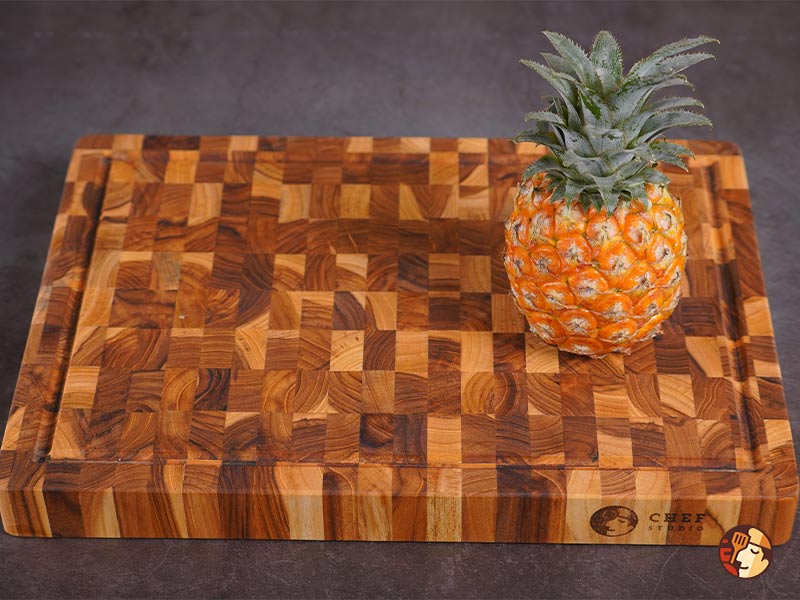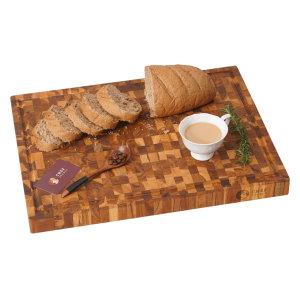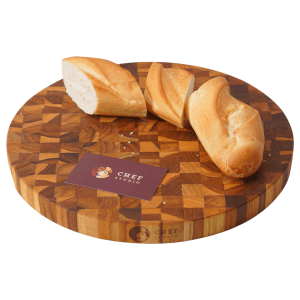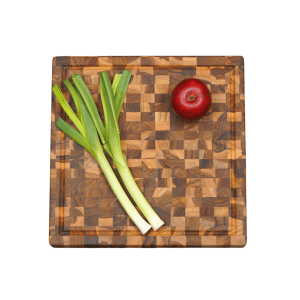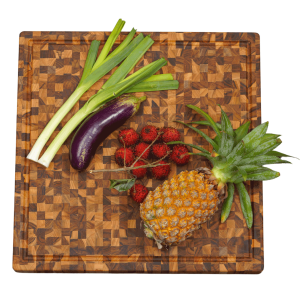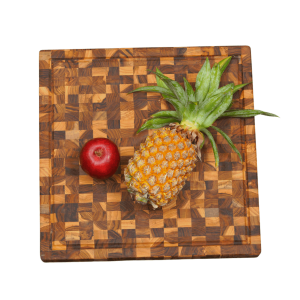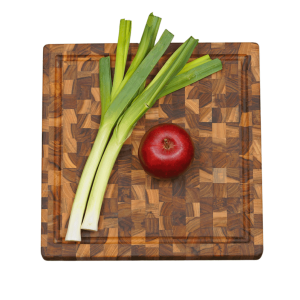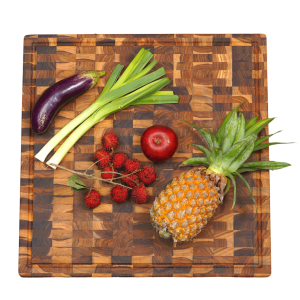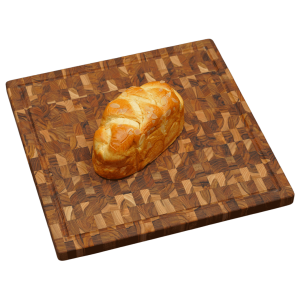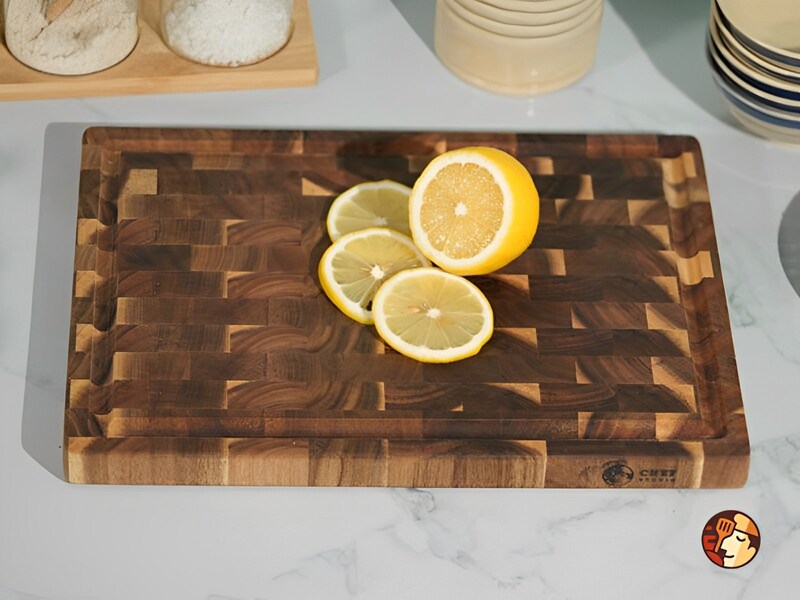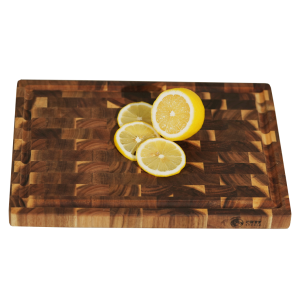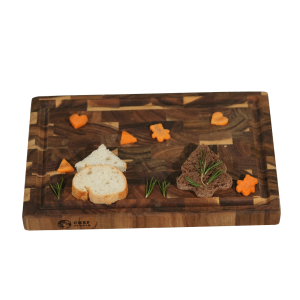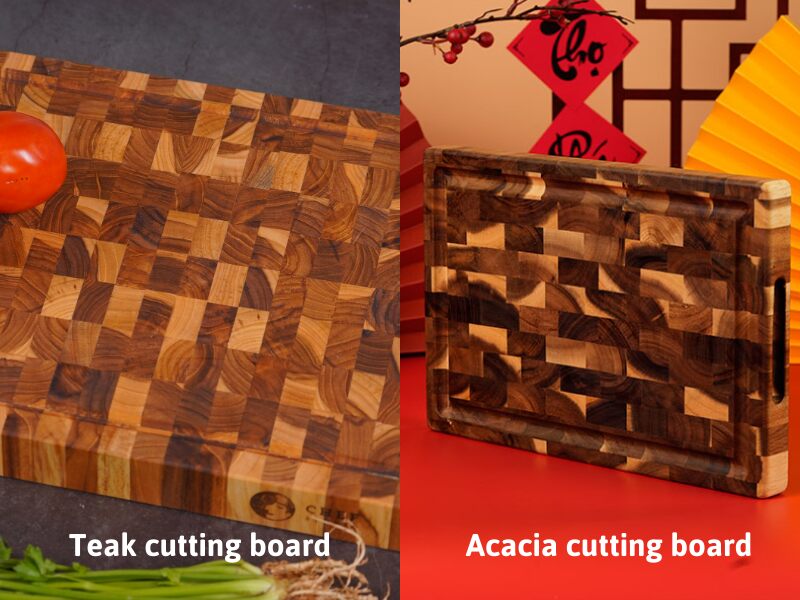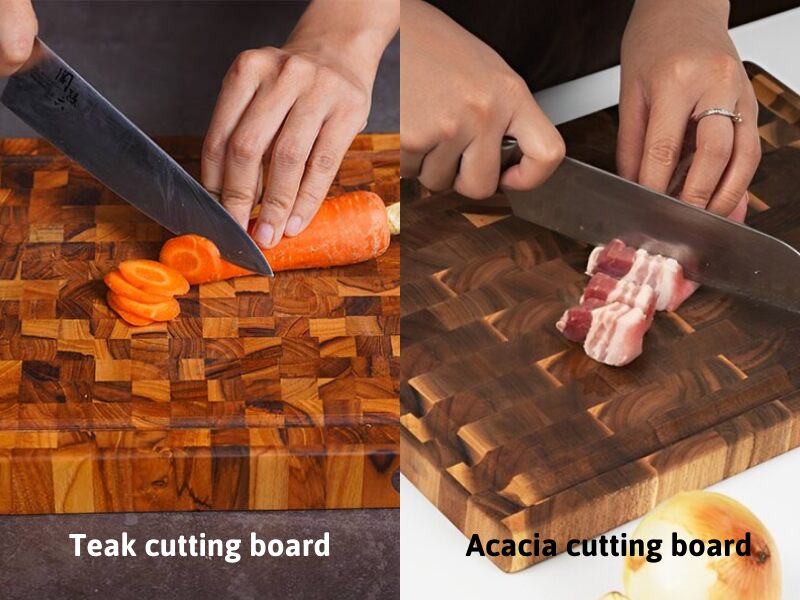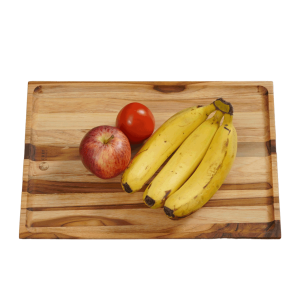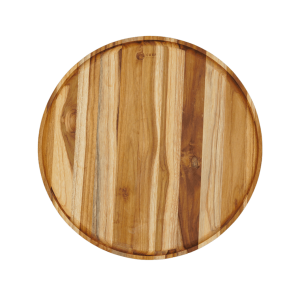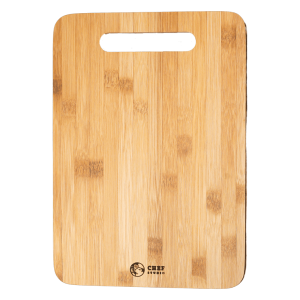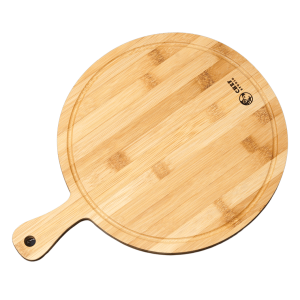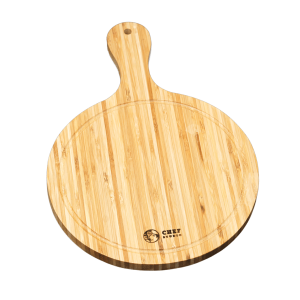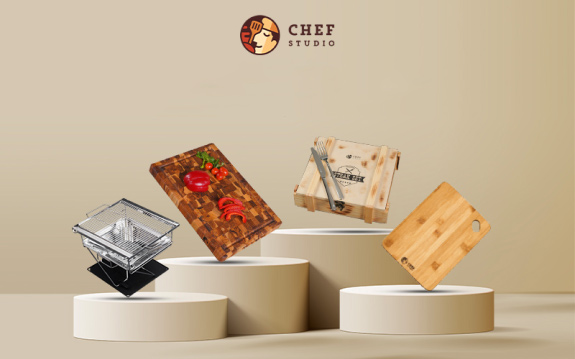Acacia vs Teak cutting board – Which is better?
Choosing the right cutting board is essential for any kitchen, and when it comes to durability, functionality, and aesthetics, two popular options stand out: acacia and teak. Both boast unique qualities that make them sought after by chefs and home cooks alike. But which one is truly better? Let’s delve into the comparison of Acacia vs Teak cutting boards with Chef Studio to find out.
Teak cutting board pros and cons
Before comparing Acacia vs Teak cutting boards, we have to learn about the characteristics of each one.
Teak cutting boards are highly regarded for their durability, attractive appearance, and resistance to moisture. However, as with any product, they have both advantages and cons.. Let’s explore the pros and cons of teak cutting boards:
Pros
Durability
Teak is known for its great toughness and longevity. It is a dense hardwood that can withstand heavy use without showing signs of wear and tear easily.
Teak wood is renowned for its high silica content, which contributes significantly to its durability. Silica is a hard and abrasive material naturally found in teak wood, enhancing its resistance to scratches, dents, and other forms of surface damage. This inherent strength makes teak cutting boards ideal for withstanding the rigors of daily use in the kitchen without showing signs of wear easily.
Moisture Resistance
Teak wood contains natural oils that play a crucial role in its durability and resistance to moisture-related issues. These oils act as a natural sealant, penetrating deep into the wood fibers to repel water and inhibit the growth of bacteria, mold, and mildew.
As a result, teak cutting boards are less prone to warping, cracking, and rotting when exposed to moisture, ensuring their longevity and performance over time.
Knife-Friendly Surface
The tight grain structure of teak wood creates a smooth and uniform surface that is gentle on knife blades. Unlike some other hardwoods, teak cutting boards are less likely to cause premature dulling or damage to kitchen knives. This knife-friendly surface allows for precise and effortless cutting, slicing, and chopping, ensuring that your knives remain sharp and effective for longer periods.
Aesthetic Appeal
Teak wood is prized for its natural beauty and distinctive appearance, characterized by warm golden-brown hues and rich grain patterns. The elegant and timeless aesthetic of teak complements various kitchen styles and décor themes, adding a touch of sophistication to any culinary space. Whether used as a cutting board or serving platter, teak enhances the visual appeal of countertops and dining tables, elevating the overall presentation of meals and culinary creations.
Cons
- Cost: Teak cutting boards tend to be more expensive than other types due to the high-quality wood and craftsmanship involved in their production.
- Weight: Teak is a dense and heavy wood, which can make teak cutting boards cumbersome to handle, especially larger-sized ones.
- Potential for scratches: While teak is resistant to scratches to some extent, it is not entirely scratch-proof. Sharp knives and heavy use over time may leave marks on the surface of the cutting board.
Read more: Should you invest in a Teak Chef Studio cutting board?
Acacia cutting board pros and cons
Acacia cutting boards are popular choices for kitchen enthusiasts due to their unique combination of characteristics. Here’s an Acacia wood cutting board review to give you more information before comparing Acacia vs Teak cutting boards:
Pros
Durability
Acacia wood cutting boards are crafted from acacia trees that have matured for over 10 years before being harvested. This extended growth period results in wood with desirable characteristics, such as density, strength, and resilience, making it well-suited for making household products.
Moisture resistance
Acacia wood exhibits natural resistance to moisture, which helps prevent warping, cracking, and splitting, even when exposed to water during washing or food preparation. This moisture resistance prolongs the lifespan of the cutting board and maintains its structural integrity over time.
Antibacterial properties
Studies have shown that acacia wood possesses inherent antibacterial properties, making it less likely to harbor harmful bacteria that can contaminate food. This feature contributes to a safer and more hygienic food preparation environment, reducing the risk of foodborne illnesses.
Stable wood quality
Acacia trees are known for their rapid growth rate, making them readily available in Vietnamese forests. This quick growth ensures a steady supply of wood without compromising quality, as the trees are harvested at the optimal age.
Despite its fast growth, acacia wood maintains a stable and consistent quality. This reliability ensures that Chef Studio’s Acacia wood cutting boards offer dependable performance and durability for household use.
Cons
While acacia wood is naturally resistant to moisture, it still requires regular maintenance to preserve its appearance and functionality. Acacia cutting boards should be washed by hand with mild soap and warm water after each use and dried immediately to prevent warping or cracking. Additionally, periodic oiling with food-grade mineral oil helps nourish the wood and maintain its luster.
In summary, acacia cutting boards offer a range of benefits, including durability, moisture resistance, antibacterial properties, attractive appearance, and versatility. While they require proper maintenance and may pose some challenges in terms of knife-friendliness and cost, the overall advantages make them a popular choice for discerning chefs and home cooks alike.
Compare Acacia vs Teak cutting board
When it comes to choosing the perfect cutting board for your kitchen, the options seem endless. Among the myriad of choices, Acacia and Teak cutting boards stand out as popular contenders, each offering unique qualities and characteristics. Let’s compare Acacia vs Teak cutting board:
Aesthetics
The easiest-to-see factor between Acacia vs Teak cutting boards is their appearance. Acacia wood presents a rich array of colors, ranging from light golden hues to deep reddish-browns. Its diverse grain patterns can vary from fine to coarse, offering a visually dynamic appearance.
On the other hand, teak’s color palette is more limited, typically displaying warm golden-brown tones with occasional variations. While teak may lack the wide spectrum of colors found in acacia, its distinct grain patterns, and subtle color shifts lend an elegant and timeless appeal to cutting boards.
Durability
Is teak better than acacia? Both acacia and teak are renowned for their durability, but they achieve this trait through different mechanisms. Teak boasts high levels of natural oils, which not only contribute to its resistance to moisture but also enhance its overall durability by repelling water and inhibiting decay.
Conversely, acacia’s durability stems from its dense structure and tight grain, which provide resilience against wear and tear. While both two kinds of wood offer exceptional longevity, teak’s innate resistance to moisture and decay may give it a slight edge in terms of long-term durability.
Acacia vs teak cutting board maintenance
Acacia cutting boards require periodic oiling to maintain their appearance, water resistance, and structural integrity. Regular application of food-grade mineral oil helps nourish the wood and protect it from drying out or warping.
In contrast, teak cutting boards are relatively low-maintenance, thanks to their high natural oil content. While occasional oiling may be beneficial for teak boards, they generally require less frequent upkeep compared to acacia.
Ease on knives
Is teak or acacia better for cutting board? The density of acacia wood can vary depending on the specific variety, with some types being exceptionally hard and dense. While this density contributes to acacia’s durability, it may pose challenges for knife edges, potentially leading to accelerated dulling or wear.
In contrast, teak’s moderate density strikes a balance between durability and knife-friendliness, offering a surface that is gentle on blades while still providing reliable performance.
Water resistance
Both acacia and teak cutting boards possess natural resistance to moisture, making them suitable choices for kitchen environments where exposure to water is common. But Teak or Acacia cutting board is better at this ability?
Teak’s abundance of natural oils provides an additional layer of protection against water damage, ensuring that the wood remains resilient even when subjected to prolonged exposure to moisture.
Acacia, while still water-resistant, may require more vigilant maintenance to prevent warping or discoloration over time.
Acacia vs teak cutting board price
In terms of cost, acacia cutting boards typically offer a more budget-friendly option compared to teak. Acacia’s widespread availability and relatively lower production costs contribute to its affordability, making it an attractive choice for budget-conscious consumers.
Teak, on the other hand, commands a higher price point due to its scarcity, premium quality, and reputation as a luxury wood. While teak cutting boards may represent a significant investment, they are often valued for their exceptional durability and timeless aesthetic appeal.
In summary, while both acacia and teak cutting boards excel in durability and water resistance, they differ in aesthetics, maintenance requirements, ease on knives, and price. Acacia’s vibrant colors and diverse grain patterns offer a visually appealing option at a more accessible price point, albeit with slightly higher maintenance needs. In contrast, teak’s timeless elegance, superior durability, and knife-friendly surface make it a premium choice for discerning customers willing to invest in long-lasting quality.
In conclusion, both Acacia and Teak cutting boards offer unique advantages and considerations for consumers. Ultimately, the decision between Acacia vs Teak cutting boards depends on individual preferences, budget constraints, and desired functionality in the kitchen.

